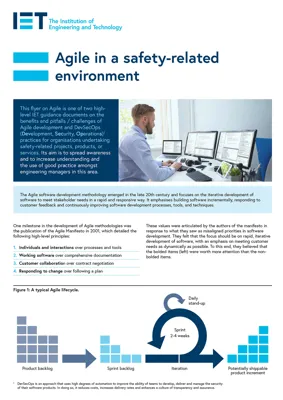Agile in a safety-related environment flyer

The Agile software development methodology emerged in the late 20th century and focuses on the iterative development of software to meet stakeholder needs in a rapid and responsive way. It emphasises building small components of software, responding to customer feedback and continuously improving software development processes, tools, and techniques.
Since its publication, a significant number of criticisms of and reflections on the Agile manifesto have been authored; practitioners recognise the need for some degree of tailoring and balancing of these principles to enable Agile to work for organisations delivering complex systems.
Organisations working in the safety-related field can assess whether adoption of Agile is appropriate for them using the questions outlined in this flyer.
This flyer on Agile is one of two high-level IET guidance documents on the benefits and pitfalls/challenges of Agile development and DevSecOps (Development, Security, Operations) practices for organisations undertaking safety-related projects, products, or services. Its aim is to spread awareness and to increase understanding and the use of good practices amongst engineering managers in this area.
A more detailed report is currently being developed and will be published shortly.
Other factfiles you may be interested in:
We’re upgrading our systems, and this includes changes to our customer and member account log in, MyIET. It’s part of our big picture plan to deliver a great experience for you and our wider engineering community.
Whilst most of our websites remain available for browsing, it will not be possible to log in to purchase products or access services from Thursday, 17 April to Wednesday, 30 April 2025. Our Member Relations team is here to help and for many of our services, including processing payments or orders, we’ll be able to support you over the phone on +44 (0)1438 765678 or email via membership@theiet.org.
We apologise for any inconvenience this may cause and thank you for your understanding.
For further information related to specific products and services, please visit our FAQs webpage.


